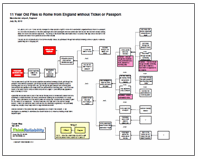By Kim Smiley
On August 6th, the Curiosity, NASA’s newest rover, safely landed on the surface of Mars. The Curiosity is better equipped and larger than previous rovers, weighing about five times as much as the Spirit and Opportunity and carrying ten times the mass of scientific instruments. This extra weight meant that the previous methods used to deliver rovers to the Martian surface wouldn’t work and NASA had to design something that had never been tried before.
What NASA came up with was the concept of using a sky crane to hover over the surface of the planet while lowering the Curiosity to a soft landing. This was a brand new design and the differences in atmosphere between earth and Mars meant it couldn’t be tested before it was launched into space. There was only one chance to get it right.
 When Curiosity, inside the Mars Science Laboratory (MSL) space probe, first hit the Mars atmosphere it was traveling approximately 13,200 miles per hour. After friction had decreased the speed by about 90%, a massive parachute was deployed to farther slow the MSL. The heatshield on the bottom was then released revealing the undercarriage of the Curiosity. The top of the probe, called the backshell, was released second along with the parachute.
When Curiosity, inside the Mars Science Laboratory (MSL) space probe, first hit the Mars atmosphere it was traveling approximately 13,200 miles per hour. After friction had decreased the speed by about 90%, a massive parachute was deployed to farther slow the MSL. The heatshield on the bottom was then released revealing the undercarriage of the Curiosity. The top of the probe, called the backshell, was released second along with the parachute.
This is the point when things start to resemble science fiction. Retro-grade rockets fired to slow down the machine inside the probe, known as the sky crane, until it hovered about 66 feet above the surface. The sky crane then slowly lowered the rover using tethers until the rover was safely on the surface.
The whole process took about seven minutes.
In an amazing feat of engineering, the Curiosity was safely put on the Martian surface in the designated area. So far the rover is functioning as designed and it is traveling the surface of another planet, transmitting data back to the earth.
Like all processes, the methods used to deliver the Curiosity can be built into a Process Map. Process Maps can be built to any level of detail desired and used in a variety of ways. A large Process Map could be built that included hundreds of boxes, documenting every detail of each component that needed to perform a task during the descent of the Curiosity for use by engineers working on the project or a higher level Process Map could be used to describe the process in general terms to give the public an overview of the procedure.
To view a high level Process Map showing how the Curiosity was delivered to the surface of Mars, click on “Download PDF” above.









